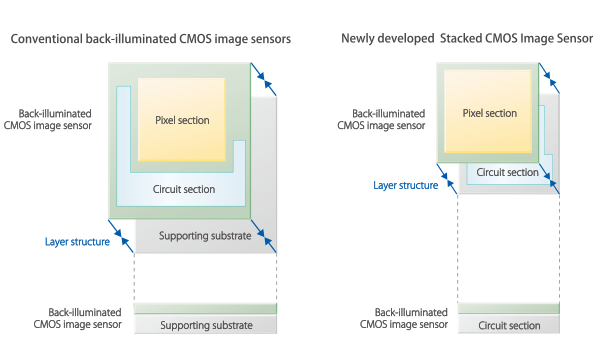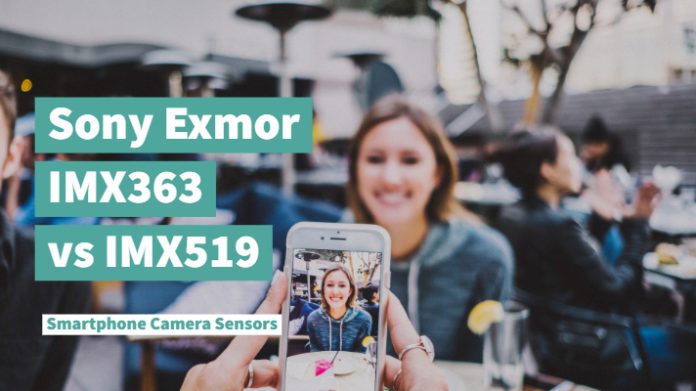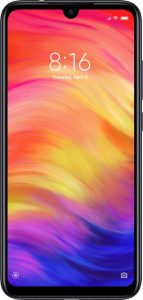Sony has been one of the prominent manufacturers of camera sensors, especially for mobiles. Whether used on the DSLRs or smartphones, the camera sensors produced by Sony have created a name for themselves. In this article, we will compare the Sony Exmor’s IMX363 vs IMX519 in today’s post. Sony has launched the Exmor technology to work with smartphone cameras. The IMX519 and IMX363 belong to this Sony Exmor genre and provide you access to an exemplary smartphone camera performance.
Also Read: Sony EXMOR IMX586 vs IMX607 Sensor
What is Exmor Technology?
Well, Exmor is a proprietary technology designed by Sony for its CMOS sensors. The technology was aimed at minimizing noise observed in the traditional CMOS sensors at higher ISO levels. The conventional sensors needed to carry analog pixel data before they are digitized.
Exmor technology digitizes the pixel data earlier in the transfer process. The analog signals tend to move slower and thus introduce noise. With the digitized content, image data travels faster, thereby avoiding the occurrence of any pixel noise.
The Sony Exmor RS sensor is designed to provide you with a stacked CMOS fabrication.

The above image should provide an insight into the technology and how it works. Let us now check out the two capable sensors and the features that it offers you.
Sony has introduced three different sensors among the Sony Exmor sensors –
- Exmor Sensors
- Exmor R sensors
- Exmor RS sensors
- Exmor imaging modules
Both these sensors come under the Exmor RS sensor category. As you are aware, the Exmor RS sensor is stacked CMOS sensor and belongs to the type that was launched back in 2012. The IMX519 happens to be one of the most recent options and offers you excellent imaging functionality.
Which is the best option between Sony IMX519 and IMX363?
The specific features that differentiate the two sensors include the following. Here are the key differentiating factors one by one.
- The IMX363 sensor supports full pixel dual core focusing. The IMX519 lacks this functionality.
- You can access 60 fps video recording features on the IMX519. On the other hand, the maximum frame rate provided by IMX363 is limited to 30 fps.
- The CMOS sensor size remains similar across both the options. Both of them have a size of 1/2.6 inches.
- If you are looking at low light performance at higher ISO levels of the sensor, you will find the IMX519 offering you a better picture reproduction than the IMX363.
Some of the advantages offered by the Sony IMX363 are a higher resolution; distortion-free images offered at low light situations, a better zoom functionality without compromising the image quality and offering clear images without any noise in low light. On the other hand, IMX519 gives you access to better video performance and better light sensitivity. You can find the differences if you check out the phones featuring the sensors.
Comparing these two sensors may not be a perfect idea. The two options have been designed for special requirements and optimize different functions. The IMX363 is used on the Google Pixel 3 devices and provides access to 12.2 MP sensor compatibility. It sports a resolution of 4032 x 3024 pixels. The IMX519 sensor, on the other hand, comes with a 16 MP sensor and has been one of the recent options and comes with better imaging capabilities.
Sony IMX519 vs Sony IMX363 – The comparison:
Launched respectively in 2016 and 2018, the IMX363 and IMX519 offer you different functionalities and features. The comparison table here should provide you with an input into the salient features that each of these sensors offers you.
| Features / Particulars | Sony IMX363 | Sony IMX519 |
| Effective resolution in MP | 12.2 MP | 16 MP |
| Effective resolution in pixels | 4032 x 3024 pixels | 4656 x 3496 pixels |
| Sensor size | 7.06 mm | 6.828 mm |
| Sensor Diagonal size | 1/2.55 inch | 1/2.6 inch |
| Individual pixel size | 1.4 microns | 1.22 microns |
| Resolutions supported and frame rates | 4032×3024 @30 fps 1920×1080 @240 fps | 4656×3496 @60 fps |
| Sub-pixel layout | RGB | RGB |
| Support for phase detection autofocus | Yes, available (Dual Pixel) | Yes, available (Dual Pixel) |
| Date of release | November 2016 | February 2018 |
Based on the above comparison, it should be clear enough that the two sensors come with almost similar features. The only difference we could observe among the two sensors is the megapixel count observed on the two competing options.
Which phones utilize the two sensors? Well, the list should be impressive enough. Have a look here.
The phones that use IMX363 include the following –
- ASUS ZenFone 5 (Amazon)
- ASUS ZenFone 5Z (Amazon)
- Xiaomi Mi MIX 2S (Amazon, )
- Xiaomi Mi MIX 3 (Amazon)
- Xiaomi Mi 8 (Amazon)
- Xiaomi Mi 8 EE (Amazon)
- Xiaomi Mi 8 SE (Amazon)
- Xiaomi Poco F1 (Flipkart)
- Nokia X7/7.1 plus (Amazon)
- ZTE Axon (Amazon)
- LG V40 ThinQ (rear primary camera) (Amazon)
- LG G8 ThinQ (rear primary camera) (Amazon)
- Smartisan R1 (Aliexpress)
- VIVO NEX[271] Google Pixel 3/3XL (Check on Amazon)
The IMX519, on the other hand, is used on the following mobile devices:
- Oppo R15[301]
- Oppo R17 (Amazon, Amazon India)
- OnePlus 6[274]
- OnePlus 6T[302] (Amazon, Amazon India)
- Motorola Moto G7 Plus (Amazon)
Does it not appear to be an impressive and exciting list? That in itself should make it an excellent option to opt for either IMX363 or IMX519 based phone. Of course, there are not many devices that utilize IMX519 for obvious reasons. The sensor has recently been launched, and we expect more devices to join the bandwagon quite soon.
To Summarize
We assume the post could guide you through a perfect comparison between the Exmor sensors from Sony. We presume the discussion above has been able to address the doubts you may have had concerning the functions and features offered by the two sensor siblings. Which sensor do you find more impressive among those two? Of course, unless you have used any of the smartphones utilizing those sensors, it may not be easy to understand the differences in a perfect manner.
IMX586 vs IMX607
The IMX607 is the new option and has not been made available as yet. This would mean the specifications have not yet officially available. However, we will try making a comparison between the two competing sensors from Sony’s stable.
| Features / Particulars | Sony IMX586 | Sony IMX607 TBD |
| Effective pixels | 48 MP | 38 MP |
| Video resolution | 4K at 90 fps 1080p at 240 fps 720p and 480p | Not available |
| Sensor size | 8 mm diagonal | 9.99mm diagonal 1/8-inch Sensor size |
| Unit pixel size | 1.6 microns | 0.8 microns |
| Sub-pixel layout | RGB | RGB+ white pixels |
| Phase detection autofocus | Yes, available | Yes, Quad Phase-detection autofocus (Q-PDAF) |
The specifications of the Sony IMX586 as available on the official website read –
Features | Sony IMX586 |
| Effective Pixels | 6000 x 8000 |
| Unit cell size | 0.8μm(H)×0.8μm(V) |
| Full frame rate | 30 fps |
| Video recording | 4K at 90 fps 1080p at 240 fps 720p at 480 fps |
| Functions | image plane phase-difference AF, HDR imaging |
| Color filter array | Quad Bayer array |
Conclusion
Do check any of those smartphones and share your views with the features offered by the sensors in each case. Do note that the sensor alone does not determine the camera quality on any phone. It is also dependent upon the camera app and software optimizations taken up by the device manufacturers. The same sensor on different devices may produce different devices and the Google Pixel is a prime example of that.
More Related Topic covered on LensXP
- Sony IMX519 vs. IMX486 vs. IMX386 vs. IMX586 vs. IMX377 Specifications Comparison
- Sony IMX486 vs Sony IMX386
- Yi 4k vs 4k+ Plus Action Cameras Specifications Comparison


